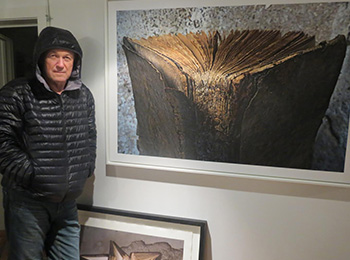Photographer Yuri Dojc was at his father’s funeral in 1997 when he met a Slovakian woman who had survived Auschwitz. This woman led the now Toronto-based photographer to a small but vibrant community of Holocaust survivors from that nation, where only around 2,500 Jews live today.
Although he had also grown up in what was then Czechoslovakia after the Holocaust, Dojc was told by his father to deny his Jewish identity in public.
“I had a need to recover something which I lost,” Dojc tells The CJN. “This [project] was a better education than anything else.”
Dojc spent more than 15 years taking portraits of survivors, as well as the last vestiges of prewar Jewish life in Slovakia. The photographs now fill a book, Last Folio, and are a memorial to those who perished during the Holocaust and those who survived but can no longer tell their stories.
Some of his photographs are on display at the Art Gallery of Ontario until June 14, 2015, as an extension of the exhibit on Lodz Ghetto photojournalist Henryk Ross.
Dojc’s urge to capture the last remnants of Jewish life was assisted by film producer Katya Krausova, who also had Slovakian roots. They traveled to their homeland with some seed money to make a documentary.
The two of them kept coming across incredible places and people, finding traces of Jewish life often by incredible luck.
In a small town in eastern Slovakia, Dojc was taking pictures of a couple when their neighbour knocked on the door. The man heard about the project and was begging to show them something.
The Christian man had a key to an old school for Jewish students before the war. Those who attended the Jewish school were deported to the camps in 1943. Ever since, much of the school remained untouched.
“The whole project changed suddenly,” Dojc says. “We couldn’t believe what we saw.”
The discovery of the Jewish school had extra meaning for Dojc, since his mother and father were teachers. Ludovit and Regina Dojc had teacher friends who were Lutheran and hid them during the Holocaust.
Dojc admits that he had little interest in the story of their survival when he was growing up in Slovakia.
“I was brought up under Communist rule. When you’re a teenager, the last thing you want to know is some heavy questions,” he says.
From this discovery, much of the rest of the project came together as a result of chance encounters. Dojc and Krausova would enter a town, only to hear from random people about cemeteries, synagogues and other portions of Jewish history that had been hidden or ignored.
The photographer was stunned when he found a prayer room with piles of books. The books look tattered, crumbling into dust due to their age. Their covers were torn, but still thick like bark.
As the creative partners sorted through the books, Krausova asked Dojc about his family history and the names of his grandparents. It turns out that, amidst the several books in the room, was one that belonged to Jakub Deutch, his grandfather.
“There were so many serendipities,” Dojc says. “Nothing was planned. We didn’t [know where to find things]. Every picture was done by some unbelievable coincidence.”
During his travels, he found a man on the cusp of renovating a vast, abandoned synagogue. The man gave Dojc the key and the photographer then made the most of his day, snapping away inside the empty, dilapidated holy site.
On another day, he was driving past a cemetery. When he stopped to look around the site, it turned out to be a Jewish burial ground.
“It was like somebody was guiding us,” he says. “I’m not a religious person but this was too many coincidences.”
The images from Last Folio have already been shown at museums around the world. On the 70th anniversary of the liberation of Auschwitz-Birkenau in January, the exhibition was featured at the UN in New York.
During this anniversary year, the photographs will be displayed in Berlin and at Moscow’s Museum of Tolerance.
Meanwhile, Krausova’s documentary of the same name is finished and is scheduled to screen in Slovakia later this year. (There is no planned distribution in North America.)
Dojc has been a commercial photographer for much of his life, ever since moving to Toronto in the late 1960s. He helped with memorable advertising campaigns for companies like Porsche, Coca-Cola, Canon and Apple, and still works for various magazines.
However, he says he was not prepared for such a personal project to consume him. Working on Last Folio reconnected Dojc to his fragmented Jewish roots.
“I can read history, I can read the Bible if I want to,” he says. “But nothing can teach you more than actually physically going through the places, walking up the steep hills with a bunch of Gypsy children, because they’re going to show you a Jewish cemetery.”
